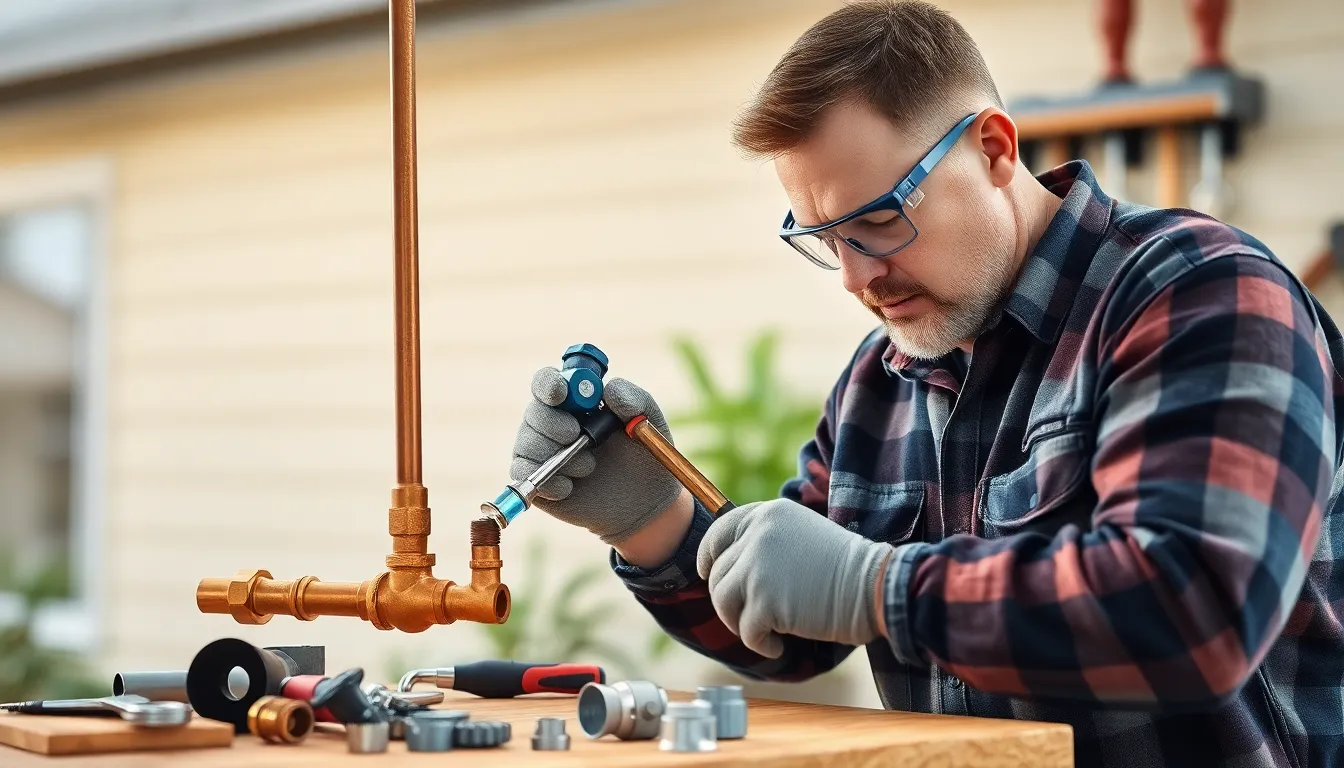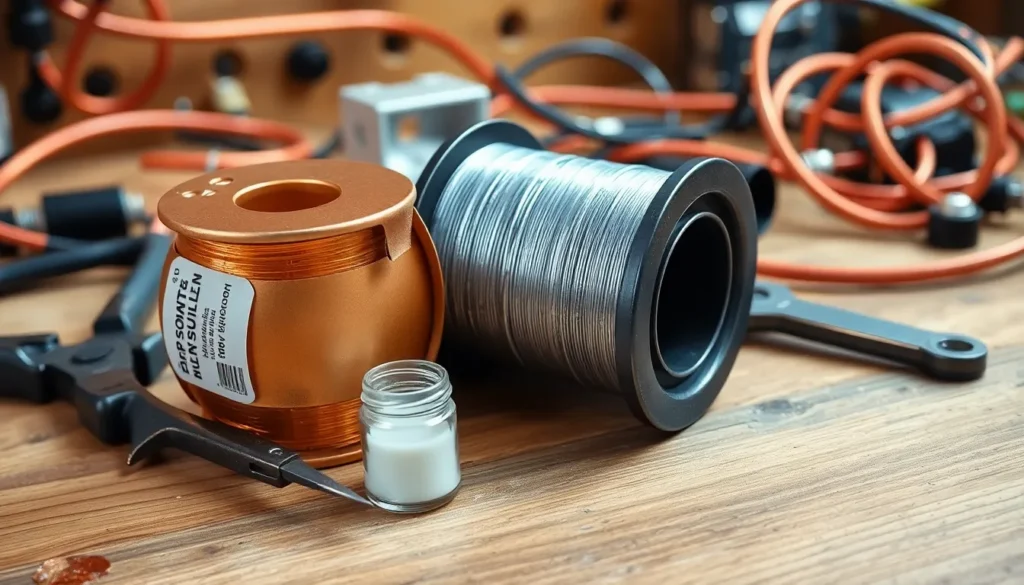Table of Contents
ToggleWhen it comes to soldering, choosing the right type can feel like picking the best ice cream flavor—everyone has a preference, but some choices just don’t mix. Plumbing solder and electrical solder might look similar, but they’re as different as a wrench and a wire stripper. One’s made for holding together pipes while the other’s designed to keep your gadgets buzzing.
Imagine trying to fix a leaky faucet with a circuit board’s favorite snack. Spoiler alert: it won’t end well. Understanding the differences between these two types of solder can save time, money, and a whole lot of frustration. So, let’s dive into the world of soldering and discover which one’s the true champion for your next project.
Overview of Solder
Solder refers to a metal alloy used to join two or more metal items together. Understanding the different solder types and their purposes is crucial for a successful project.
Definition of Solder
Solder is a fusible alloy that melts at a relatively low temperature, creating a strong bond when cooling. Primarily, it consists of tin and lead or lead-free materials like copper. Applications vary widely, from plumbing to electronics. Knowing the specific requirements of each project helps in choosing the right solder.
Types of Solder
Different solder types exist, each designed for particular applications. Plumbing solder typically contains no lead due to health concerns and complies with safety regulations. Electrical solder often includes lead for improved conductivity but has lead-free variations available. Many DIY enthusiasts prefer to select solders based on their melting point and flow characteristics, ensuring compatibility with their materials.
Plumbing Solder

Plumbing solder plays a crucial role in connecting pipes and fittings in plumbing systems. This specific solder ensures a strong, durable seal that prevents leaks.
Composition and Materials
Plumbing solder typically comprises a blend of tin and copper, with many formulations avoiding lead entirely. Health concerns regarding lead exposure prompted manufacturers to focus on lead-free alternatives. Lead-free options often include metals like silver or bismuth, which maintain effective bonding capabilities. The melting point generally ranges from 430°F to 450°F, accommodating various plumbing applications. Ensuring proper composition and material choice is vital for creating safe and effective connections in household plumbing systems.
Applications in Plumbing
Plumbing solder primarily attaches copper pipes, creating watertight joints critical for both residential and commercial applications. It’s essential in projects involving water supply lines, heating systems, and gas piping. Installation requires the use of a torch to melt the solder and facilitate the joining process. Proper technique often involves cleaning and fluxing surfaces to ensure optimal adhesion. Professionals rely on this solder in repairs, new installations, and maintenance tasks to uphold plumbing integrity and safety. Understanding these applications helps individuals select the right solder for their plumbing needs.
Electrical Solder
Electrical solder is essential for effective connections in electronic devices. It comes in various forms tailored to specific needs.
Composition and Materials
Electrical solder generally consists of a tin-lead alloy, providing excellent conductivity and a lower melting point. It often contains 60% tin and 40% lead, known as 60/40 solder, for optimal performance. Lead-free variants exist, primarily using tin with silver or copper, catering to safety and environmental concerns. These alternatives have slightly higher melting points but maintain comparable flow characteristics. Durability emphasizes proper bonding in electronic assemblies. Manufacturers prioritize these materials to ensure reliability in electrical connections.
Applications in Electronics
Electrical solder plays a crucial role in circuit assembly, providing reliable connections for components like resistors and capacitors. It facilitates joining wires on printed circuit boards, enhancing device functionality. Smartphone assembly and computer manufacturing rely heavily on quality solder for optimal performance and longevity. Hobbyists and professionals alike use electrical solder in various applications, from repairing electronics to building custom circuit projects. Understanding its role helps in achieving successful outcomes in any electronics work.
Key Differences Between Plumbing Solder and Electrical Solder
Understanding the key differences between plumbing solder and electrical solder is essential for successful projects. Each type serves unique purposes and adheres to specific requirements.
Melting Points and Temperature Resistance
Plumbing solder generally melts at temperatures between 430°F and 450°F. This range is suitable for most plumbing applications, such as connecting copper pipes. Electrical solder, in contrast, often features a lower melting point due to its tin-lead alloy composition or its lead-free variants. Typical melting points for electrical solder hover around 361°F to 374°F, making it ideal for delicate electronic connections. Resistance to heat varies significantly; plumbing solder accommodates both high-temperature water systems and gas lines, while electrical solder maintains its integrity in low-voltage environments. Selecting the right solder based on melting points ensures effective performance and safety.
Regulatory Standards and Safety Considerations
Regulatory standards play a critical role in the selection of solder types. Plumbing solder must comply with health guidelines, steering clear of lead due to its toxicity. This consideration leads to the use of lead-free solder containing materials like copper and tin. Electrical solder, however, often includes lead, which enhances conductivity but raises safety concerns. Lead-free options do exist, typically incorporating silver or copper instead. Maintenance of quality control standards is essential in both types; these measures ensure safety and environmental compliance. Awareness of regulatory requirements helps prevent adverse effects during each application.
Understanding the differences between plumbing solder and electrical solder is essential for anyone tackling DIY projects. Each type serves a unique purpose and comes with specific requirements. Using the wrong solder can lead to costly errors and safety hazards.
Plumbing solder creates strong seals for pipes and fittings while ensuring compliance with health regulations. On the other hand, electrical solder is crucial for effective connections in electronic devices, providing excellent conductivity. Recognizing these distinctions not only enhances project outcomes but also promotes safety and longevity in both plumbing and electrical applications. Choosing the right solder is key to achieving successful results in any project.




